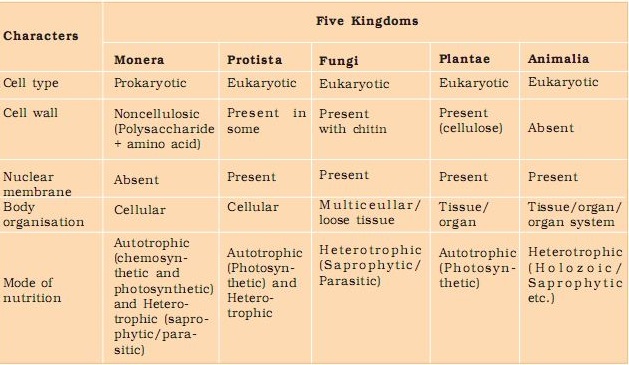Biological Classification MCQ Questions /objective with answers Class 11 Biology Chapter 2
1. Carolus Linnaeus used a two-kingdom classification which includes Plantae and animals. Currently, we use:
- a. Three kingdom classification.
- b. Four kingdom classification.
- c. Five kingdom classification.
- d. None.
2. Who gave The five-kingdom in 1969:
- a. Carolus Linnaeus.
- b. Ernst Mayer.
- c. R.H. Whittaker.
- d. None.

Table of Contents
3. Demerits of two-kingdom classification is/are:
- a. Does not differentiate between autotroph and heterotroph.
- b. Unicellular and multicellular organisms, both occupy the same group.
- c. Prokaryote and eukaryote have the same group.
- d. Does not differentiate between the chitinous cell wall of fungi and the cellulosic cell wall of plants.
- e. All.
4. Unicellular prokaryotes find his place in five kingdom classification as:
- a. Monera.
- b. Protists.
- c. Fungi.
- d. None.
5. The oldest prokaryote is/are:
- a. Archaebacteria.
- b. Cyanobacteria.
- c. Blue-green alga.
- d. None.
6. Study of archaebacteria is important because:
- a. They are available in harsh conditions.
- b. They differ from other bacteria in cell wall composition.
- c. Both.
- d. None.
7. Single-celled eukaryotes find his place as _ _ _ _ in five kingdom classification.
- a. Monera.
- b. Protista.
- c. Fungi.
- d. None.
8. Most protists are:
- a. Aquatic.
- b. Terrestrial.
- c. Aerial.
- d. None.
9. We classify protists into:
- a. Chrysophyste which includes diatoms, golden algae.
- b. Dinoflagellates which include Gonyaulax.
- c. Euglenois which includes Euglena.
- d. Saprophytic protists which include slime mold.
- e. Protozoans which includes amoeba.
- f. All.
10. The common mushroom and toadstool that we see commonly belong to:
- a. Monera.
- b. Protista.
- c. Fungi.
- d. Plantae.
11. Scavengers of the earth are:
- a. Monera.
- b. Protista.
- c. Fungi.
- d. Plantae.
12. Which among these is/are useful fungi:
- a. Fermentation yeast.
- b. P. chrysogenum producing penicillin.
- c. Edible mushrooms.
- d. All.
13. Most fungi are :
- a. Autotroph.
- b. Hetrotroph.
- c. Chemolithotroph.
- d. None.
14. Lichen is symbiosis (mutual cooperation) between:
- a. Protists and fungi.
- b. Algae and fungi.
- c. Protists and algae.
- d. None.
15. Mycorrhiza is a symbiotic association between the roots of some plants with _ _ _ _ _.
- a. Monera.
- b. Protista.
- c. Fungi.
- d. Plantae.
- a. Fragmentation.
- b. Fission.
- c. Budding.
- d. Any of these.
17. Reproduction by spore formation like conidia or sporangiophores is a:
- a. Vegetative reproduction.
- b. Asexual reproduction.
- c. Sexual reproduction.
- d. None.
- a. Vegetative reproduction.
- b. Asexual reproduction.
- c. Sexual reproduction.
- d. None.
19. How do we classify fungi?
- a. Mycelium morphology.
- b. Mode of spore formation.
- c. Fruiting body.
- d. All of the above.
20. We call sac fungi to:
- a. Phycomycocetes.
- b. Ascomycetes.
- c. Basidiomycetes.
- d. Deuteromycetes.
21. P. chrysogenum is a fungus that produce penicillin. This fungi belong to:
- a. Phycomycocetes.
- b. Ascomycetes.
- c. Basidiomycetes.
- d. Deuteromycetes.
22. “Fungi imperpecti” is:
- a. Phycomycocetes.
- b. Ascomycetes.
- c. Basidiomycetes.
- d. Deuteromycetes.
23. We see “alternation in generation” in :
- a. Monera.
- b. Protista.
- c. Fungi.
- d. Plantae.
24. We see nutrition by ingestion “holozoic” in:
- a. Monera.
- b. Protista.
- c. Fungi.
- d. Plantae.
25. There is no place for virus, viroids, prions in five kingdom classification. Because:
- a. Their structure do not match with any group.
- b. Viruses are not truly living.
- c. None.
Next:
- The Living world MCQ Biology Questions
- Biological Classification MCQ Questions with answers
- Plant Kingdom MCQ Biology Class Eleven
- Animal Kingdom MCQ Biology
- Morphology of Flowering Plants MCQ
- Anatomy of Flowering Plants MCQ Biology
- Structural Organisation in Animals MCQ
Answers:
| 1. c | 7. b | 13. b | 19. d |
| 2. c | 8. a | 14. b | 20. b |
| 3. e | 9. f | 15. c | 21. b |
| 4. a | 10. c | 16. d | 22. d |
| 5. a | 11. c | 17. b | 23. d |
| 6. c | 12. d | 18.c | 24. b |
| 25.b |
Biological Classification MCQ Questions /objective with answers Class 11 Biology Chapter 2
Ref: Chapter 2, NCERT.
Superb.. very helpful
It is really good question of biological classification
Super
It was helpful at the very moment
It was very helpful .
it’s fantastic